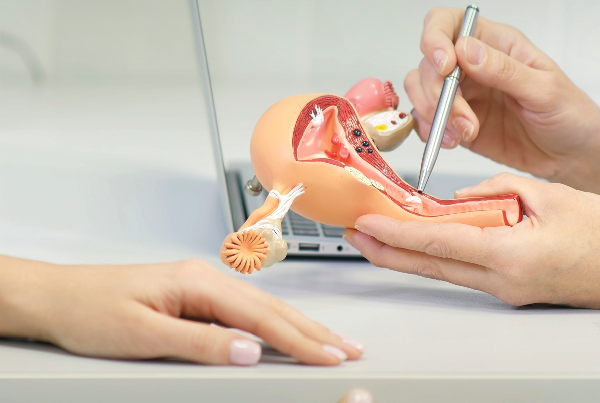
Gynaecology
- PUBERTY
Puberty in girls is the transition from childhood to adulthood. There are profound biological, morphological, and psychological changes that lead to full maturity and eventually fertility. Five important physical changes are evident during this period .these are breast, pubic, and axillary hair growth, growth in height, and finally menstruation. Most of these changes occur gradually but only menarche(menses) can be datedijm
Menarche is the first mensuration in life. It may occur anywhere between 10 to 16 years. but the peak time is 13 years.
Some Problems Related to Puberty Are:-
PRECOCIOUS PUBERTY:-
Term precocious puberty is reserved for girls who exhibit any secondary sex characteristics before age of 8 years or menstruate before age of 10 years.
DELAYED PUBERTY:-
Puberty is said to be delayed when the breast tissue and or pubic hair have not appeared by 13-14 years or menarche appears as late as 16 years.
PUBERTY MENORRHAGIA:-
Initial periods may be heavy or prolonged due to anovulation. Mostly adequate explanation, reassurance, and psychological support are required. Rarely does it require further investigation and treatment is required.
- MENOPAUSE
Menopause means permanent cessation of menstruation at the end of reproductive life due to loss of ovarian follicular activity. It is the point of time when the last and final menstruation occurs. Due to increased life expectancy, especially in affluent societies, about one-third of the life span will be spent during the period of estrogen deprivation stage with long-term symptomatic and metabolic complications.
The clinical diagnosis is confirmed following the stoppage of menstruation (amenorrhea) for twelve consecutive months without any other pathology.
The Important Symptoms and the Health Concerns of Menopause Are:-
- Vasomotor symptoms
- Urogenital atrophy
- Osteoporosis and fracture
- Cardiovascular disease
- Psychological changes
- Skin and Hair
- Sexual dysfunction
MANAGEMENT
Prevention
Spontaneous menopause is unavoidable.
Counseling: Every woman with postmenopausal symptoms should be adequately explained about the physiologic events. This will remove her fears, and minimize or dispel the symptoms of anxiety, depression, and insomnia. Reassurance is essential.
TREATMENT
Non-Hormonal Treatment
- Lifestyle Modification
- Balanced Diet
- Calcium and Vitamin D Supplementation
- Exercise
- Cessation of Smoking and Alcohol
- Bisphosphonates
- SERMS
- Gabapentin
- Phytoestrogens
- Soyproteins
Hormonal Treatment
Considering the risks, hormone therapy should be used with the lowest effective dose and for a short period of time
- PELVIC INFLAMMATORY DISEASE
PID is a disease of the upper genital tract. It is a spectrum of infection and inflammation of the upper genital tract organs. Pelvic inflammatory disease is a major problem for the reproductive health of young women. PID may be asymptomatic or subclinical.
The onset may be acute or insidious and the clinical picture varies widely depending on the severity and spread of the infection. But the chief complaints of varying magnitude are fever, lower abdominal and pelvic pain, and offensive vaginal discharge following delivery or abortion.
Symptoms
- Patients with acute PID present with a wide range of non-specific clinical symptoms.
- Bilateral lower abdominal and pelvic pain which is dull in nature. The onset of pain is rapid and acute.
- There is fever, lassitude, and headache.
- Irregular and excessive vaginal bleeding is usually due to associated endometritis.
- Abnormal vaginal discharge which becomes purulent and or copious.
- Nausea and vomiting.
MANAGEMENT
After the initial pelvic examination, blood investigations are sent. Many require further investigation.
Treatment Includes:-
Outpatient therapy: Apart from adequate rest and analgesic, antibiotics are to be prescribed even before the microbiological report is available. Because the infection is polymicrobial in nature, instead of a single, a combination of antibiotics should be prescribed.
Inpatient therapy: The patients are to be hospitalized for antibiotic therapy in the same conditions Bed rest is imposed. Oral feeding is restricted. Dehydration and acidosis are to be corrected by intravenous fluid. Intravenous antibiotic therapy is recommended for at least 48 hours.
- MENSTRUAL IRREGULARITY
Dysmenorrhea means painful menstruation. But practically it is painful menstruation of sufficient magnitude so women are unable to do day-to-day activities.
Types:-
PRIMARY DYSMENORRHEA (Spasmodic)
Primary dysmenorrhea is one where there is no identifiable pelvic pathology.
Incidence: The incidence of primary dysmenorrhea is about 12 to 20 percent. With the advent of oral contraceptives and non-steroidal anti-inflammatory drugs, there is marked relief of the symptom. It is predominantly confined to adolescent girls. It usually appears within 2 years of menarche.
Clinical features: The pain begins a few hours before or just with the onset of menstruation. The severity of pain usually lasts for a few hours and may extend to 24 hours but seldom persists beyond 48 hours. The pain is spasmodic and confined to the lower abdomen; may radiate to the back and medial aspect of thighs. Systemic discomforts like nausea, vomiting, fatigue, diarrhea, headache, and tachycardia may be associated. The abdominal examination does not reveal any abnormal findings. For the detection of any pelvic abnormalities, ultrasound is very useful and it is not invasive.
Treatment: General measures include improvement of general health and simple psychotherapy in terms of explanation and assurance. Usual activities including sports are to be continued. During menses, the bowel should be kept empty; mild analgesics and antispasmodics may be prescribed. With these simple measures, the pain is relieved in the majority.
Drugs: The drugs are used in a minority of cases which include:-
- Prostaglandin synthetase inhibitors
- Oral Contraceptive pills
SECONDARY DYSMENORRHEA
(Congestive)
Secondary dysmenorrhea is menstrual pain associated with pain occurring in the presence of pelvic pathology.
Common Causes of Secondary Dysmenorrhea:
Cervical stenosis, chronic pelvic infection, pelvic endometriosis, pelvic adhesions, adenomyosis, uterine fibroid, endometrial polyp, IUCD in utero, and pelvic congestion. Obstruction due to Mullerian malformations is the other cause.
Patient profile: The patients are usually in their thirties; more often parous and unrelated to any social status.
Clinical features: The pain is dull, situated in the back and in front without any radiation. It usually appears 3–5 days prior to the period and relieves with the start of bleeding. The onset and duration of pain depend on the pathology producing the pain. Abdominal and vaginal examinations usually reveal the offending lesion. At times, the lesion is revealed by laparoscopy, hysteroscopy, or laparotomy
Treatment: The treatment aims at the cause rather than the symptom. The type of treatment depends on the severity, age, and parity of the patient.
- ABNORMAL UTERINE BLEEDING
Menorrhagia is defined as cyclic bleeding at normal intervals; the bleeding is either excessive in amount or duration.
Pelvic:
- Fibroid uterus
- Adenomyosis
- Pelvic endometriosis
- IUCD inutero
- Chronic tubo-ovarian mass
- Tubercular endometritis (early cases)
- Retroverted uterus—due to congestion
Systemic:
- Liver Dysfunction
- Congestive Cardiac Failure.
- Severe Hypertension.
Endocrinal
- Hyperthyroidism
Hematological
Idiopathic Thrombocytopenic Purpura.
Leukemia.
Von Willebrand’s Disease.
Platelet Deficiency
Diagnosis
The long duration of flow, the passage of big clots, the use of an increased number of thick sanitary pads, pallor, and low levels of hemoglobin give an idea about the correct diagnosis and magnitude of menorrhagia.
Treatment
The definitive treatment is appropriate to the cause of menorrhagia.
POLY MENORRHEA
Definition
Polymenorrhea is defined as cyclic bleeding where the cycle is reduced to an arbitrary limit of fewer than 21 days and remains constant at that frequency.
METRORRHAGIA
Definition: Metrorrhagia is defined as irregular, acyclic bleeding from the uterus. The amount of bleeding is variable. In fact, it is mostly related to surface lesions in the uterus.
Menometrorrhagia is the term applied when the bleeding is so irregular and excessive that the menses (periods) cannot be identified at all.
Treatment
Treatment is directed to the underlying pathology. Malignancy is to be excluded prior to any
OLIGOMENORRHEA
Definition: Menstrual bleeding occurring more than 35 days apart and which remains constant at that frequency is called oligomenorrhea.
Cause
- Age-Related during adolescence and preceding menopause
- Weight-RelatedObesity
- Stress and Exercise-related
- Endocrine Disorders PCOS (commonest), hyperprolactinemia, hyperthyroidism
- Androgen-Producing Tumors ovarian, adrenal
- Tubercular Endometritis late cases
Drugs:
- some drugs can also cause
- DYSFUNCTIONAL UTERINE BLEEDING (DUB)
Definition: DUB is defined as a state of abnormal uterine bleeding without any clinically detectable organic, systemic, or iatrogenic cause (Pelvic pathology, e.g. tumor, inflammation, or pregnancy is excluded).
Heavy menstrual bleeding (HMB) is defined as bleeding that interferes with a woman’s physical, emotional, social, and maternal quality of life.
What Can You Expect
Internal examination: Bimanual examination including speculum examination should be done in all cases.
Special investigations
- Blood values: Hemoglobin estimation is done in every case along with platelet count, prothrombin time, bleeding time, and partial thromboplastin time.
- Ultrasound and Color Doppler(Transvaginal sonography (TVS): is very sensitive to detect any anatomical abnormality of the uterus, endometrium, and adnexae.
- Hysteroscopy: is done for better evaluation of endometrial lesions and to take a biopsy from the offending site under direct vision.
- Laparoscopy: To exclude unsuspected pelvic pathology
- Diagnostic Uterine Curettage (D and C)
MANAGEMENT GENERAL
Rest is advised during the bleeding phase. Assurance and sympathetic handling are helpful particularly in adolescents. Anemia should be corrected energetically by diet, hematinics, and even by blood transfusion. Clinically evident systemic or endocrinal abnormalities should be investigated and treated accordingly.
MEDICAL MANAGEMENT OF DUB
- Hormones: With the introduction of potent orally active progestins, they became the mainstay in the management of DUB in all age groups
- Progestins: The common preparations used are norethisterone acetate and medroxyprogesterone acetate.
- Prostaglandin synthetase inhibitors (PSI)
- Fenamates (Mefenamic acid)
- Antifibrinolytic Agents
- Tranexamic Acid (TA)
- TIntrauterine progestogen: LNGIUSis recommended as a first-line therapy for a woman with HMB in the absence of any structural or histological abnormality.
SURGICAL MANAGEMENT OF DUB
- Uterine Curettage
- Endometrial Ablation / Resection
- Hysterectomy


